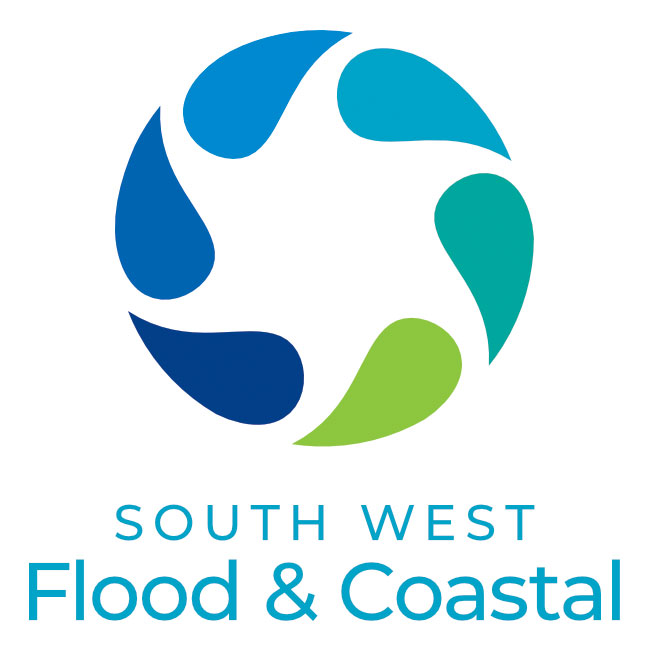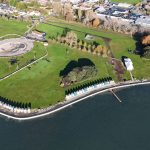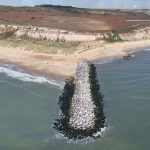Completed Projects
Beach Renourishment, winter 2020/21
Part of a 17-year Beach Management Scheme to protect our coastal frontages, making them more climate resilient.
LEAD AUTHORITY
BCP Council

WORKING WITH
START DATE
January 2021
END DATE
31st March 2021
Video courtesy Boskalis Westminster
Project Overview
Seven depleted beach areas from Southbourne to Poole were renourished in a £7.5 million scheme which delivered 350,000m³ of sand and beach material to the coastline. Some 1.3km of sinkerline (underwater pipe) stretched out to sea to connect with the dredger so that material could be pumped ashore. Up to 2km of shoreline pipe was then used to distribute the sand and beach material.
Renourishment areas
The beach locations requiring a top-up included Solent Path to St Catherine’s Path, Gordon’s zig-zag to Fisherman’s Walk, Boscombe Pier, East Cliff, West Cliff to Middle Chine and either side of Shore Road in Poole. The maps below are indicative of where the renourishments took place. The sequencing and location of works were continually reviewed and adjusted, based on the latest survey data and operating efficiencies. Generally, the renourishments moved from east to west along the coast.
Video courtesy ITV Meridian, February 2021 at Southbourne
Works updates
26 March 2021: The last pump of sand and beach material from Poole Harbour’s Swash Channel took place at Shore Road today. The pipes will be dismantled and stacked on the beach to be removed from 29th March. Thank you to everyone for their patience while the beach renourishments took place.
23 March: The underwater sinkerline pipe was moved to its final postion at Canford Cliffs (east of the pavilion) to enable Flaghead Chine and Shore Road to receive renourishments (see top-up site locations 1 and 2 on the maps above). Access from Sandbanks to Shore Road will mostly be maintained across the back of the beach but may be closed for a few hours at a time for safety reasons while the pumping takes place.
15 March: To speed up the process of collection and pumping of beach material, two dredgers are operating between Poole Bay and the dredge site. Once the top-up locations around Bournemouth are complete, the sinkerline pipe will be moved near to the BIC to enable Middle Chine / Durley Chine Beach to be renourished (see top-up location site 3 map above).
01 March: The renourishment of Southbourne beaches is complete. During the pump of the last load, there was a hitch with the coupling device between the dredger and sinkerline pipe but this was resolved. By the end of this week the sinkerline pipe will be relocated near to the East Cliff lift in Bournemouth and the shoreline pipes will be moved and built across the sand to Boscombe to enable the sand to be pumped in top-up locations 4 and 5 (see maps above). The renourishment of these areas is expected to take up to 2 weeks.
16 February: Our contractors will be testing their method of pipe movements underneath Boscombe Pier this week. Please avoid this area while these works are carried out and keep dogs on leads. The renourishment of top-up location 7 will finish by the end of this week and begin at top-up location 8. See maps (above) for details.
06 February: The Willem Van Oranje dredger arrived in Poole Bay during the early hours to begin the beach renourishment programme. See our video footage which shows the pump operation in action.
27 January: Approx 1km of sinkerline pipe was towed from Holland and arrived in Poole Bay. It was carefully manoeuvred into position near Gordon’s zig-zag and filled with air to sink it. The dredger will connect to it and pump sand/beach material into the shoreline pipe.
From early January 2021: Sections of pipe started to be connected and were laid out along Southbourne beach.
From mid-December 2020: Large machinery and sections of shoreline pipe were delivered and stored on the beach, east and west of Boscombe Pier.
The pumping operation
Dredger, Willem Van Oranje sails into Poole Bay with a full hopper of sand and beach material; with the help of a support boat connects to the floating section of pipeline. The material is then mixed with water and pumped to the beach to top-up the depleted areas, where it is moved around by large machinery and the beach reprofiled to protect it from coastal erosion. The video below, filmed on 12th February, and another at the top of this page, illustrate these operations.
About our beaches and beach replenishment
A soft engineering approach...
In Poole Bay, sandy beach material is currently our frontline defence. Our cyclic beach renourishments are a “soft” engineering approach which provides an economical, attractive and sustainable form of coast protection that works with natural processes.
Harder engineering approaches such as rock revetments or rock armour are the opposite. If used, this style of coastal defence would be placed at the back of the beaches making access to the sand and sea difficult. The levels of sand would continue to drop, and more rock would be needed to prevent the failure or collapse of the sea wall.
The right beach level...
We continually analyse sea levels, wave parameters and storm data, as well as monitoring beach levels to ensure our coastline is maintained at the correct height and width. If beach levels were allowed to drop significantly, inshore wave energy would not be attenuated and sea water could run up and over the crest, flooding the areas behind the beach. Low beach levels would also cause the sea wall to be undermined, leading to sea wall failures or collapse and ultimately, the erosion of the cliffs would accelerate. Our modelling suggests this would be by up to 1m per year in some places.
Impact of climate change...
It is now widely acknowledged that sea levels are rising because of climate change; +20cm since 1900. This may result in the need to raise the level of the promenade but for now, even small changes in sea levels require a higher and wider beach. This prevents overtopping and acts as a buffer to prevent erosion in-between renourishments. An additional benefit of a high and wide beach is the amenity value enjoyed by residents and visitors alike.
As sea levels continue to rise, it is anticipated there will be an increase in stormy weather too. In January 2021, Dr Matt Wadey, BCP Council’s Senior Coastal Scientist delivered the findings of a SCOPAC Storm Analysis Study* to the Royal Geographical Society. The study helps us to better understand how our region is affected by storms, how their frequency and intensity is changing, and their potential impact on beach loss and asset failures.
*The SCOPAC Storm Analysis Study technical report is available at southerncoastalgroup-scopac.org.uk
Natural renourishments and beach material...
Until the 1970s, 10,000 years of erosion into our coastline’s soft cliffs deposited various sands, clays and gravels onto our native beaches. If you look at the exposed areas of the cliff today, you will see these differing materials capped by the river terrace gravels of the Stour.
To limit the process of the natural erosion of the cliffs and to prevent the coastline from rolling back, the sea wall was constructed. It was built in numerous stages; the Bournemouth, Boscombe and Southbourne sections date from the late 1800s, while other parts were built in the 1940s, during WWII. The beach levels started to fall because the material in Poole Bay is generally transported by wave action eastwards towards Hengistbury Head, before eventually being deposited offshore. This process is called longshore drift.
In the 1970s beach renourishments started to be used to sustain the beach levels and provide coast protection. This means that the BCP coastline beaches are now largely artificial, i.e. they are not a result of local cliff erosion, and with only a few per cent remaining of what was the original “native” material.
Imported sand and beach material...
In Poole Bay, the strategically placed groynes help retain beach levels and slow down the process of longshore drift, but studies have shown that we continue to undergo net sand losses of approx. 70,000m³ annually. Cyclic beach renourishments are therefore required to ensure that we maintain a high and wide beach.
Most of the sand and beach material for the 2021 renourishments will be sourced from Area 501, a licenced dredge site on the UK’s east coast in the Thames Estuary region. During the renourishments, continual checks are made to ensure the imported materials closely match the existing (and previous) beaches whilst complying with specifications for coastal protection. All works are carried out in accordance with the Marine Management Organisation licence and planning consent.
Initially, the colour of the pumped sand and beach material may look slightly darker but after a short period will lighten-up as it dries out and is exposed to the atmosphere. Over the coming months the wave action will sort it into a more natural beach profile, and initially you may see the temporary formation of ‘cliffing’ along the water’s edge.
Sand recycling and sustainability...
Currently, Area 501 in the Thames Estuary region is the closest site in the UK with the material grading we need to match the existing beach. As stocks become depleted and increase in price, we may have to travel further afield to Europe to source it but this would become uneconomical.
To plan for this eventuality, we are starting to investigate more sustainable ways of renourishing our beaches. One way is to recycle our own sandy beach material because the size and type matches our current beaches. In Poole, we hope to recycle material from the harbour’s main Swash Channel and during Spring 2021 we have a planned sand recycling scheme in Christchurch, from Mudeford Sandbank to Highcliffe
Wind-blown sand...
The particle size of sand and beach material varies naturally across Poole Bay. Generally, at Sandbanks it is fine sand, grading to coarser and heavier material towards Hengistbury Head where the more aggressive wave climate removes the finer element. When imported beach material sorts itself into a natural profile, the finer materials remain on the surface while the heavier materials move downwards.
During storm events, the wind moves the finer particles to the back of the beach (and then onto the promenade) but in some areas, this natural process (along with dune regeneration work instigated in the mid-1990s*), has resulted in sand dune creation with self-seeded marram grasses holding them in place. Dunes provide an additional layer of tidal flood defence in front of the sea wall.
A high and wide beach is vital for coast protection purposes, fulfilling the prime objective of preventing reactivation of the cliff and loss of homes. Therefore, it is not an option to intentionally lower the beach levels to prevent sand from ‘creeping’ onto the promenade. Sand is cleared from the promenade, to maintain access for all beach users and emergency vehicles. In the future, especially with dwindling beach material supplies, we may need to consider slightly increasing the size of our sand and beach material. This would also be expected to help reduce the amount of sand blown onto the promenade.
* For more about the dune regeneration see Report-on-Sandbanks-Works-2003.pdf
Managing the marine environment...
To carry out these coastal works, it is vital we understand the impacts on the marine environment and to use this information to inform what we do. For years we have also worked collaboratively with many stakeholders including researchers at the Universities of Southampton and Bournemouth, Fishery Liaison Officers, Environment Agency and Southern Inshore Fisheries & Conservation Authority to ensure any impact is kept to an absolute minimum.
Since 2015, we have carried out annual environmental assessments. Divers have undertaken surveys in numerous areas across the frontage including near Hengistbury Head to assess whether there has been an increase in fine sediment release. No significant increases in bare, un-colonised horizontal surfaces were noted between 2015 and 2018. This suggests that marine life (including lobsters and Sea Bream) is not being affected by beach renourishments or any other particulates within the water column. This has been evidenced in our marine licence application and as a result we received approval from the Marine Management Organisation to deliver Phases 2 and 3 of the Poole Bay Beach Management Scheme.
What you can expect to see during the works
The images below are from previous beach renourishments but show what you will see during the works. Enlarge the images to read the captions…
Access to the beaches
In the immediate vicinity of the works, the beaches will be closed for safety reasons but access to the promenade will be maintained to enable you to pass by safely. At Shore Road (Poole) we aim to maintain access across the back of the beach. Wet sand can become unstable underfoot so the top-up locations will remain closed for a few days after the works are completed until the sand dries out and becomes compact, stable and safe to walk on again.















